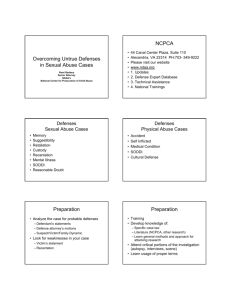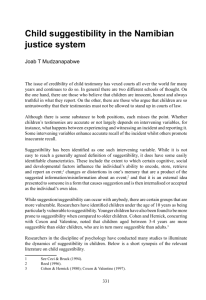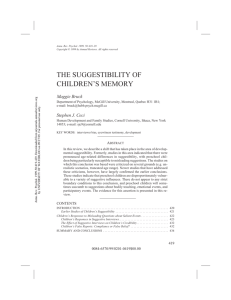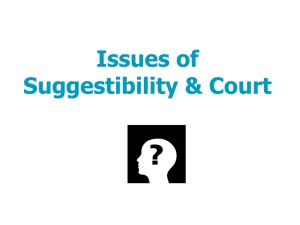Let's Not Exaggerate the Suggestibility of Children
advertisement
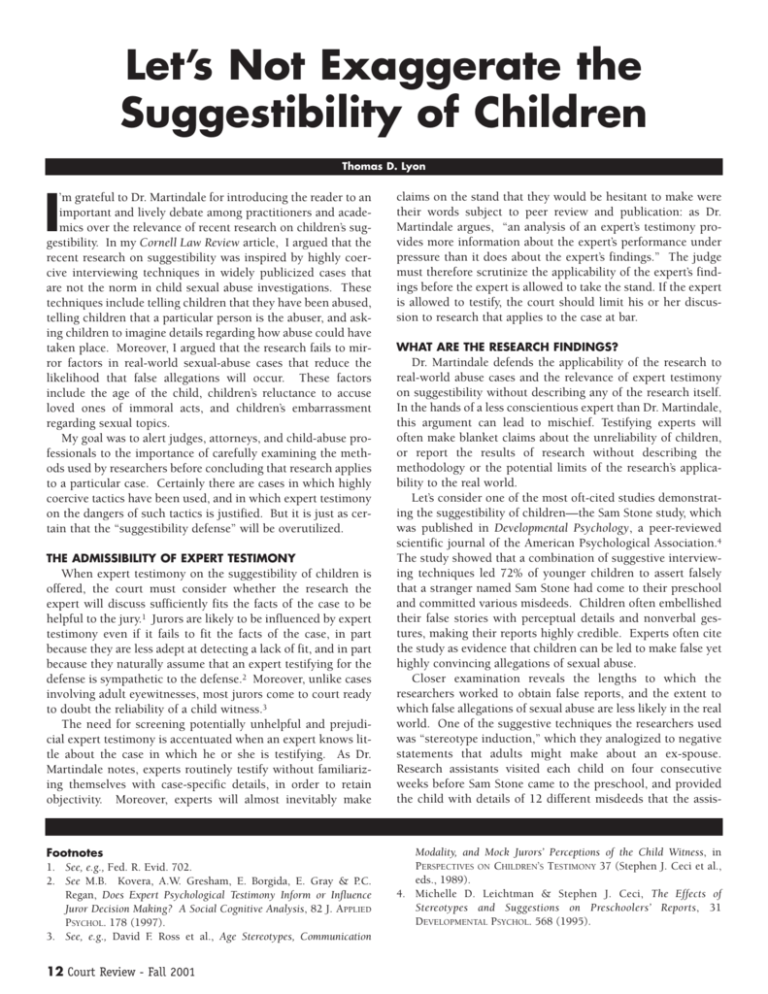
Let’s Not Exaggerate the Suggestibility of Children Thomas D. Lyon I ’m grateful to Dr. Martindale for introducing the reader to an important and lively debate among practitioners and academics over the relevance of recent research on children’s suggestibility. In my Cornell Law Review article, I argued that the recent research on suggestibility was inspired by highly coercive interviewing techniques in widely publicized cases that are not the norm in child sexual abuse investigations. These techniques include telling children that they have been abused, telling children that a particular person is the abuser, and asking children to imagine details regarding how abuse could have taken place. Moreover, I argued that the research fails to mirror factors in real-world sexual-abuse cases that reduce the likelihood that false allegations will occur. These factors include the age of the child, children’s reluctance to accuse loved ones of immoral acts, and children’s embarrassment regarding sexual topics. My goal was to alert judges, attorneys, and child-abuse professionals to the importance of carefully examining the methods used by researchers before concluding that research applies to a particular case. Certainly there are cases in which highly coercive tactics have been used, and in which expert testimony on the dangers of such tactics is justified. But it is just as certain that the “suggestibility defense” will be overutilized. THE ADMISSIBILITY OF EXPERT TESTIMONY When expert testimony on the suggestibility of children is offered, the court must consider whether the research the expert will discuss sufficiently fits the facts of the case to be helpful to the jury.1 Jurors are likely to be influenced by expert testimony even if it fails to fit the facts of the case, in part because they are less adept at detecting a lack of fit, and in part because they naturally assume that an expert testifying for the defense is sympathetic to the defense.2 Moreover, unlike cases involving adult eyewitnesses, most jurors come to court ready to doubt the reliability of a child witness.3 The need for screening potentially unhelpful and prejudicial expert testimony is accentuated when an expert knows little about the case in which he or she is testifying. As Dr. Martindale notes, experts routinely testify without familiarizing themselves with case-specific details, in order to retain objectivity. Moreover, experts will almost inevitably make Footnotes 1. See, e.g., Fed. R. Evid. 702. 2. See M.B. Kovera, A.W. Gresham, E. Borgida, E. Gray & P.C. Regan, Does Expert Psychological Testimony Inform or Influence Juror Decision Making? A Social Cognitive Analysis, 82 J. APPLIED PSYCHOL. 178 (1997). 3. See, e.g., David F. Ross et al., Age Stereotypes, Communication 12 Court Review - Fall 2001 claims on the stand that they would be hesitant to make were their words subject to peer review and publication: as Dr. Martindale argues, “an analysis of an expert’s testimony provides more information about the expert’s performance under pressure than it does about the expert’s findings.” The judge must therefore scrutinize the applicability of the expert’s findings before the expert is allowed to take the stand. If the expert is allowed to testify, the court should limit his or her discussion to research that applies to the case at bar. WHAT ARE THE RESEARCH FINDINGS? Dr. Martindale defends the applicability of the research to real-world abuse cases and the relevance of expert testimony on suggestibility without describing any of the research itself. In the hands of a less conscientious expert than Dr. Martindale, this argument can lead to mischief. Testifying experts will often make blanket claims about the unreliability of children, or report the results of research without describing the methodology or the potential limits of the research’s applicability to the real world. Let’s consider one of the most oft-cited studies demonstrating the suggestibility of children—the Sam Stone study, which was published in Developmental Psychology, a peer-reviewed scientific journal of the American Psychological Association.4 The study showed that a combination of suggestive interviewing techniques led 72% of younger children to assert falsely that a stranger named Sam Stone had come to their preschool and committed various misdeeds. Children often embellished their false stories with perceptual details and nonverbal gestures, making their reports highly credible. Experts often cite the study as evidence that children can be led to make false yet highly convincing allegations of sexual abuse. Closer examination reveals the lengths to which the researchers worked to obtain false reports, and the extent to which false allegations of sexual abuse are less likely in the real world. One of the suggestive techniques the researchers used was “stereotype induction,” which they analogized to negative statements that adults might make about an ex-spouse. Research assistants visited each child on four consecutive weeks before Sam Stone came to the preschool, and provided the child with details of 12 different misdeeds that the assis- Modality, and Mock Jurors’ Perceptions of the Child Witness, in PERSPECTIVES ON CHILDREN’S TESTIMONY 37 (Stephen J. Ceci et al., eds., 1989). 4. Michelle D. Leichtman & Stephen J. Ceci, The Effects of Stereotypes and Suggestions on Preschoolers’ Reports, 31 DEVELOPMENTAL PSYCHOL. 568 (1995). tants had purportedly witnessed Sam perform. Sam Stone’s visit was two minutes long, and he did not interact with individual children. Another suggestive technique the researchers used was suggestive questioning. For four weeks after Sam’s visit, an interviewer questioned each child each week. In the first interview, the interviewer showed the child a soiled teddy bear and a ripped book and asked the child to speculate who might have done it. In the next three interviews the interviewer asked a series of highly suggestive questions. These questions presupposed that Sam Stone had ripped the book or soiled the teddy bear, did not give the child an opportunity to deny that he had done so, and asked the child to choose among details of the fictitious events. For example, “Did Sam Stone rip the book with his hands, or did he use scissors?” “When Sam Stone got the bear dirty, did he do it by accident, or on purpose?” These questions were asked regardless of whether the child affirmed or denied that Sam Stone had performed any misdeeds. Ten weeks later, all children were interviewed in a nonleading fashion. At that time, 72% of the three and four year olds implicated Sam in one or both misdeeds. The high rates of false reports are impressive. But equally impressive are other details of the study that are often overlooked. First, the authors report “dramatic developmental trends” in children’s susceptibility to the suggestive techniques.5 The rate of false reports among the older preschoolers, who were five to six years of age, was about half of that of the younger children. School-age children would be even less likely to succumb to the interviewer’s pressures. One of the most consistent findings in the suggestibility literature is that preschool children are particularly vulnerable to suggestive questioning, and preschool children predominate in recent research documenting the unreliability of children’s testimony. Second, the study was unusual in that the final interview contained two questions mildly skeptical of the children’s claims. Asking children if they saw the events reduced the number of false reports by about half. Asking the children, “You didn’t really see him rip the book (or soil the bear), did you?” cut the number by half again. Having been exposed to four trials of stereotype induction and three trials of suggestive questioning, 21% of the three and four year olds (and only 5% of the five and six year olds) maintained that the misdeeds had occurred. Dr. Martindale might respond that he is not reassured by these numbers, and I would agree that any false allegation of sexual abuse is devastating, not only for the accused, but also for the child and his or her family. Yet these percentages exaggerate the likelihood that a child will accuse a familiar adult of sexual abuse, compared to [T]he issue is not the likelihood that a child whether children will accuse a stranger of ripping a book or soiling a can be led to make teddy bear. How close the false allegations, numbers get to zero is anybut whether they body’s guess. The Sam Stone study are being led by illustrates a number of current investigative important facts about sugmethods. gestibility research. First, there are large age differences in suggestibility. I am struck by how many experts appear to overlook the truism that just as preschoolers are much more suggestible than school-age children, school-age children are much less suggestible than preschoolers. Second, children are both suggestible and counter-suggestible. Researchers often fail to test the persistence of their suggestions; Sam Stone is an exception, and dramatically reduced the number of false reports. Third, much of the suggestibility research elicits false narratives from young children by telling them that the events occurred (as opposed to merely asking them), and by providing them with details with which they can imagine the events. Indeed, these are the techniques researchers have used to create substantial numbers of false childhood memories in adults. But the issue is not whether children can be led to make false allegations, but whether they are being led by current investigative methods. 5. Id. at 568. 6. Id. at 569. 7. See, e.g., Amye R. Warren et al., “It Sounds Good in Theory, But....” Do Investigative Interviewers Follow Guidelines Based on Memory Research?, 1 CHILD MALTREATMENT 231 (1996). Michael Lamb, Kathleen Sternberg, and collegues at the National Institute of Child Health and Development have conducted a number of studies demonstrating how interviewers tend to ask closed-ended rather than open-ended questions. For one of the most recent examples, see Kathleen J. Sternberg, Michael E. Lamb, Graham M. Davies, & Helen L. Westcott, The Memorandum of Good Practice: Theory Versus Application, 25 CHILD ABUSE & NEGLECT 669 (2001). 8. See Maggie Bruck, Stephen J. Ceci, & Helene Hembrooke, Reliability and Credibility of Young Children’s Reports: From Research to Policy and Practice, 53 AM. PSYCHOL. 136, 139 (noting increase in suggestibility as one moves from yes/no questions to questions that presuppose the truth of the suggested information, e.g., “Is there a cabinet in the room?” to “Isn’t there a cabinet in the room?” to “Is the door open in the cabinet in the room?”). WHAT SORT OF INTERVIEWS ARE OCCURRING IN THE REAL WORLD? Leichtman and Ceci asserted that the techniques in the Sam Stone study were based on “real-world forensic conditions.”6 In my 1999 paper, I questioned the applicability of the Sam Stone study and other studies to the real world, pointing out that the research on actual interviews had not documented the widespread use of techniques such as stereotype induction. What had been documented was that interviewers were asking very few open-ended questions, and relying heavily on closedended questions (yes-no questions and forced-choice questions).7 Closed-ended questions are often considered “leading,” and I believe they are being overused. In my presentations to child interviewers, I emphasize the need for structured interview protocols and the potential benefits of rapport building and greater use of open-ended questions as means of increasing information without reducing reliability. All the same, closed-ended questions are far less leading than the kind of questions asked in studies like Sam Stone.8 They are Fall 2001 - Court Review 13 less offensive than many of the techniques documented in the notorious day-care cases like Kelly Michaels and the McMartin case. Closed-ended questions are also necessary in some cases.9 Abused children are often quite reluctant to describe abuse that was painful, shameful, and embarrassing.10 After my article appeared, Amye Warren and her colleagues set out to test my claims on a sample of 42 child abuse interviews conducted in the late 1980s and early 1990s. Their conclusion? “We believe that our results regarding the frequency of problematic techniques in ‘typical’ child sexual abuse interviews are encouraging. It appears that the assumptions made by Lyon (1999) about the rarity of some of the most egregious interviewing practices (e.g. referring to what other people have said) in ‘typical’ interviews may be well-founded.”11 The authors issued several caveats: the interviews might not be representative of all interviews, and the researchers might have both missed some suggestive techniques, and counted some harmless interactions as suggestive.12 Most importantly, the authors stressed that the infrequent use of improper techniques does not make an interview a good interview. Nevertheless, the study supported my basic assertion: studies like Sam Stone exaggerate the suggestiveness of real-world interviews. In response to the relative infrequency of the highly suggestive techniques favored by suggestibility researchers, Dr. Martindale argues that the “deleterious effect of one strong suggestion from an authoritative source is not likely to be diminished simply because it is followed by numerous nonsuggestive questions.” I know of no research to support this assertion, and Dr. Martindale does not offer any. The recent research on preschool children’s suggestibility does not stop with “one strong suggestion.” It is the dogged persistence of coercive interviewers that reliably produces false narratives in young children. The cases that inspired the research involved unrelenting suggestion over long periods of time by interviewers utterly convinced that abuse had occurred. The mistakes committed by investigative interviewers in less sensational cases tend to be much more mundane. We clearly need to improve the quality of interviewing: we should provide more training, more supervision, and more resources. But the liberal receipt of expert testimony on the effects of highly suggestive interviewing techniques on preschool children is more likely to simply increase the number of acquittals across the board than to improve interviewing practice. CONCLUSION I agree with Dr. Martindale that the recent research on children’s suggestibility has done a lot of good. It has spawned 9. See Stephen J. Ceci and Richard D. Friedman, The Suggestibility of Children: Scientific Research and Legal Implications, 86 CORNELL L. REV. 33, 46 (2000) (“There is no serious doubt that directed questioning will often be far more effective than requests for free recall in securing disclosure of abuse.”). 10. See Thomas D. Lyon, The New Wave in Children’s Suggestibility Research: A Critique, 84 CORNELL L. REV. 1004, 1046 (1999). 11. Amye R. Warren, Sena Garven, Nancy E. Walker, & Cara E. 14 Court Review - Fall 2001 several research programs aimed at improving the process by which children are interviewed about abuse. In appropriate cases, it can educate judges and jurors about the dangers of highly suggestive interviewing with young children. It has largely silenced extremist claims that children’s abuse allegations are never false or that children are no more suggestible than adults. However, we must not forget that the extremist claims were founded on overgenerous interpretations of research finding surprisingly low rates of false reports among young children. Research highlighting high rates of error can easily lead to similarly unfounded claims about children’s reliability. These claims, in turn, can reinforce commonsense doubts about children’s reliability and inherent reluctance to confront child sexual abuse. The solution is quite straightforward: judges must take care to assess the applicability of suggestibility research on a caseby-case basis. Experts seeking to testify must describe the research with sufficient specificity to allow the court to assess whether the research fits the fact of the case. If it doesn’t fit, you don’t admit. Similarly, suggestibility research offered for other purposes (such as for assessing the reliability of hearsay) should be scrutinized with similar care. Judges should keep in mind the importance of the child’s age, the suggestive influences at issue, and the relationship of the child to the alleged offender. Through judicious gatekeeping, extremist claims about suggestibility can be kept out of the courtroom. Thomas D. Lyon is a law professor at the University of Southern California School of Law. He obtained his law degree magna cum laude from Harvard University School of Law in 1987 and earned a Ph.D. in psychology from Stanford University in 1994. He has been on the faculty at the USC law school since 1995, where he teaches evidence, psychology and law, and quantitative methods in law. Before joining USC, he served as a research associate at Harbor-UCLA Medical Center and was an attorney with the Children’s Services Division of the Los Angeles County Counsel’s office. Professor Lyon can be reached at tlyon@law.usc.edu. Woodall, Setting the Record Straight: How Problematic Are ‘Typical’ Child Sexual Abuse Interviews? (paper presented at the biennial meeting of the American Psychology-Law Society, New Orleans, Louisiana, March 2000) (copy on file with author). 12. For example, using the phrase “do you think” was classified as an example of asking the child to speculate about past events or to use imagination or solve a mystery. Id






